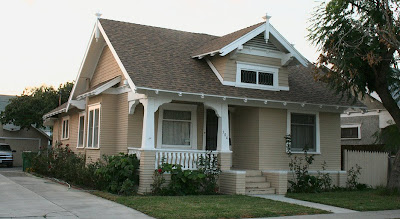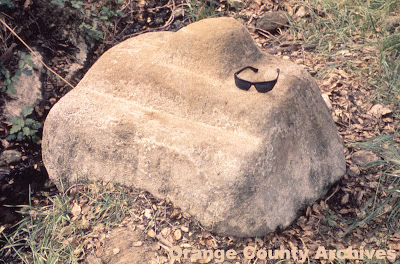
(
Continued from 11-28-08...) The second leg of our
Irvine Ranch Conservancy tour took us to the site of
Orange County’s worst air disaster.
.
At 1:35 a.m. on June 25, 1965, under fog and light drizzle, an Air Force C-135A transport jet, (see contemporary photo above), took off from
MCAS El Toro. (The C-135 is the military equivalent of a Boeing 707.) The plane was en route from McGuire Air Force Base in New Jersey to Okinawa, with another scheduled stop at Hickam AFB in Hawaii. Aboard were 71 Marines on their way to Vietnam, along with 12 U.S. Air Force crew members.
.
At 1:46 a.m., about 4 miles from the control tower, the jet disappeared from radar. For reasons unknown, the pilot did not (or could not) make a planned left hand turn and flew directly into
Loma Ridge. The plane was destroyed, killing all 83 people on board.
.Navy sailor
Steve Bedunah was scheduled to take the flight as far as Hawaii. However, a family emergency waylayed him. He arrived at El Toro just in time to see the plane heading down the runway. Seconds later, he saw a huge orange fireball. "I was supposed to be on that plane," he said in a 2005
O.C. Weekly interview, "I've spent 40 years trying to live that down."

Here you see
Greg from
KOCE-TV filming
Mike Bornia,
Chris Epting, and
Maria Hall-Brown at the crash site. It was fitting (although unplanned) that we visited this site on
Veteran’s Day. A group called
Project Remembrance is planning to put a stone memorial here in the near future.

The jet was about 1,150 feet up and traveling at 300 mph when it impacted the hill, scattering wreckage and bodies across at least a mile. The bodies and all the large plane parts were recovered after the crash, but small bits of the jet are still strewn everywhere. Although mangled in the crash, many metal parts are still in remarkably good condition after 43 years of exposure to the elements. Just last year, a readable set of dog tags were found in the brush.
.
It turned out that our traveling companion
Jim had once been part of a search/clean-up crew after a different MCAS El Toro crash on the
Irvine Ranch. He had some very sobering tales to tell that I won't relate here.
Update (11-3-2013): Chris Hoctor sent me the following message and list:
"For the benefit of your readers, this is the complete list of the crew and passengers based on everything I could find (all 84). Many little details added, a number of names, middle names, and places corrected here. Some missing rank, could not find that."
The twelve crew:Pilot: Capt. William F. Cordell, JR., 27, GA
Copilot: First Lt. John A Zietke, JR., 27, MI
Copilot: First Lt. Gary M. Rigsbee, 23, CA
Navigator: Capt. Jacques G. Senecal, 32, CA
Navigator: First Lt. Robert H. K. Shannon, 29
Flight Engineer: S/Sgt James E. Burns, 29, IL
Load Master: S/Sgt Bobby L. Calhoun, 28
Flight Engineer: M/Sgt William H. Meredith, 34, KY
Flight Engineer: T/Sgt Marlin W. Tatom, 41, MI
Load Master: Airman 3/C Elwood C. Van Nole, Jr., 19
Flight traffic specialist: Airman 1/C Charles A. Reives, 23
Cadet Gary L. Zimmerman, 20, class of 1967, Air Force Academy
Passengers killed (alphabetical by last name):Dwight L. Aldridge, 18, AR
PFC Russell J. Babcock, JR., 19, Tomkins Cove, NY
PFC Roger J. Beiter, 18, W. Seneca, N. Y.
Lance Cpl William B. Breen, 20, Bellefonte, Penn.
Cpl James Harold Brock, 25, Birmingham, Ohio.
Cpl Emerson K. Brown, 24, Kent, Wash.
Lance Cpl John G. Brusso, Jr., 22, Ontario, N. Y.
Cpl George C. Burrow, 20, Norman, Ark.
Cpl Tucker Ross Burt, 24, Mt. Vernon, Ohio.
Phillip V. Caraccio, 24
Cpl Paul T. Chapin, 21, Coronado, Calif.
Cpl George E. College, 21, Davisburg, Mich.
Donald A. Davidson, 19, MI
Lance Cpl Douglas D. Everett, 19, Allentown, Pa.
PFC Rosco Ford, 24, Miami, Fla.
Capt Victor M. Girodengo, 28, San Diego, Calif.
Cpl Thomas Barton Gladstone, 25, Largo, Fla.
PFC Dickie L. Glover, 32, Muskegon, Mich.
PFC Gerald Griffith, 18, Jackson, Miss.
Henry D Grimm, 18
Lance Cpl Howard D. Hall, 18, Winfield, Kan.
Lance Cpl Gail K. Haning, 23, Albany, Ohio.
Cpl Charles Harmon, 21, Estill, S. C.
Lance Cpl Robert E. Harvey, 18, Upland, Calif.
PFC Harry R. Hawk, 20, Oberlin, Penn.
PFC Gerald G. Hawkins, 18, Mableton, Ga.
Kenneth J Haywood, 21
Thomas K Heacox, 18
Lance Cpl Danny E. Holder, 18, Nashville, Tenn.
Joseph M Kelly, 18
PFC James T. Kitchens, 19, Madleton, Ga.
Cpl William R. Kittel, 28, Suisun City, Calif.
Sgt James E. Lee, 28, Compton, Calif.
Richard W Leeman, 19
Robert C Lisicki, 23
Cpl Michael J. Mando, JR., 22, Tayler, Pa.
Lance Cpl Brian Elvin Martin, 20, Minersville, Pa.
Cpl James V. Matruski, 23, Johnson City, N. Y.
Henry B McKine, 18, CA
James D Meade, 21
PFC Joseph D Mogelinski, 18, Greenfield, Mass.
Capt Edward M. Morehead, 27, Pittsburgh, Pa.
Sgt James C. Moultrie, 18, Moza City, Okinawa.
Cpl Anthony E. Nelson, 22, Wilmington, Calif.
PFC Franklin Newman, 20, Loomis, N. J.
Cpl Rich G. Pacheco, 20, Portland, Ore.
Lance Cpl Enrique Danny Padilla, 20, Santa Rosa, N. M.
Cpl Michael A. Palmieri, 28, Elmira, N. Y.
Lance Cpl Alfred Eugene Peterson, 20, Littleton Commons, Mass.
Cpl Edward P. Ray, 23, no hometown listed.
PFC Robert J. Rhodes, 19, Patterson, N. J.
PFC Ronald Richard Richert, 18, Pontiac, Mich.
Cpl Lawrence O. Rohde, 22, Las Vegas, NV
PFC Gerald W. Ross, 19
Pvt. Robert S. Shedis, 22, Calumet Park, Ill.
PFC Joseph B. Sheppard, 18, Philadelphia, Pa.
Sgt Jackson Sinyard, Jr
Pvt. Gerald Skidmore, 18, Cincinnati, Ohio.
PFC Arthur Slaughter, 23, Pittsburgh, Pa.
Quinton Smith, 22
Theodore Eugene Stark, 24, Louisville, KY
Lance Cpl Charles L. Stevens, 18, Cambridge, Ohio.
Jimmie I. Swink, 26
Lance Cpl James C. Tischer, 20, Hannibal, Mo.
Cpl Timothy M. Treweek, 24, Los Angeles
PFC Lawrence R. Vanness, 19, Rochester, N. Y.
Elwood C Vannote, 19
Cpl Harrison Wallace, 25, Clemens, Ala.
David E. Walsh, 18
Ralph E White, 23, IN
James R. Wilson, 24, IN
William J Wilson, 29, MO
.
(To be
continued...)
 Here's an ad for the Pacific Electric Railway's "Red Cars" and buses, from the Dec. 31, 1950 issue of the Huntington Beach News. Today they'd also tell you that it was "green" to take mass transit.
Here's an ad for the Pacific Electric Railway's "Red Cars" and buses, from the Dec. 31, 1950 issue of the Huntington Beach News. Today they'd also tell you that it was "green" to take mass transit.
















































